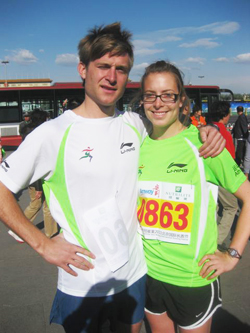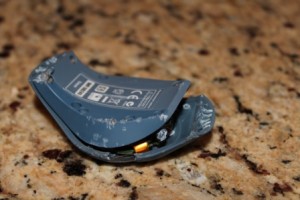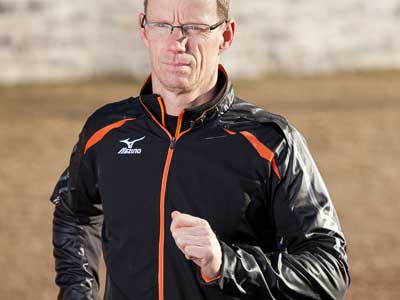Notes to My 21 year-old Self
It seems that I run lists of things I would tell my younger self, if I could go back in time. The things I would tell my ‘student-self’, my ‘single-self’ and so on. I do, quite often, contemplate what I would tell my ‘running self’ at 21 years old. I will focus on that here, as I have had lots of running time lately to think about it!
I was 21 when I ran my very first marathon. I had never actually been in a race before. I had run cross-country races in high school, but never a chip-timed race, sans high school running singlet. I had been running quite consistently for a couple of years with my brother, and we decided it would be cool to do a race. I guess we think big! We looked up spring marathons online (with our fancy dial-up internet–this was more than 10 years ago!) and decided the Ottawa Race Weekend would be our goal. Now. They had a half marathon as well, but, in our very young, naive minds, we wanted to go, “the entire way” (21-year-old me was a tad pretentious?) so we signed up for the full marathon. Back to the internet we went, looking up, “how to train for a marathon.” We followed our training schedules, which I fondly remember printing off and taping to the back of my door, all colour-coded and optimistic.
Race day came, and my parents proudly cheered us on as we ran the race in Ottawa. In the last few kilometres, I tried to convince my brother that it was alright if he left me on the side of the road to die. I just wanted my legs to stop screaming at me! With a lot of encouragement on his part, we approached the finish line and I have never felt so proud. And tired. And sore. We finished in a time of 4:18:xx.

I have grown as a runner in the last 10 years ++
I have grown as a runner in the last few years, and specifically, the last few months. As I ran intervals yesterday, plugging away through the pain of 5 x 5 minutes of hard running, I realized that my 21 year-old self didn’t know to appreciate workouts like that. My 21 year-old self didn’t know how huge it is to be crossing off days on the calendar in anticipation of a big race like Boston.
Here are some notes I have for my running self, at 21:
1. Don’t be a fair-weather runner. Seriously. If it is snowy/cold/raining, that hot shower will feel even more rewarding! Suck it up. That episode of “Friends” you’re watching instead of getting out there will be in syndication for years to come, you can watch it later. Trust me.
2. Go to bed. On time. Getting your sleep will make you smarter and healthier, and those early morning runs will feel so much better. Also, don’t sleep the day away because you don’t have class until noon. Get out there and soak up some vitamin D!
3. Sign up for more races! It is such a fun way to reward yourself for your daily running efforts. Especially 5 and 10 km races. Get those fast PB’s in now, so you can brag for a few years.
4. Use your gym membership! Ugh, how I wish I could go back and shake myself. Strength training is so important, and so is using something you are paying for already, as I was back then.
5. Eat better. No, cereal for dinner doesn’t cut it. No, pasta isn’t a good dinner choice every night. Stop being lazy! Get some groceries and enjoy some good, healthy food!
6. Learn to swim. Take it from me, you have the time now, but you won’t have as much time in 12 years when you are juggling 3 children, a hubs that works shifts, and a full-time job of your own. I know, you love running so much you don’t feel like you need another ‘sport’, but wouldn’t it be great to look like you have it together in a pool, instead of flailing about, like you do now?!
7. Think about recovery runs. I know, your 21-year-old body seems to bounce back without issue, but think about how great your next run or speed work would be, if you think about recovery as well.
8. Stay hydrated. Coffee Pubs and Bars also have water available, as strange as that concept is to you, 21-year-old!
9. You’ve got a lot of years of running ahead of you. As cool as the marathon is, don’t feel as though you need to conquer it all now! You will have children, and having them will only make you appreciate your running more, and make you into a much more dedicated runner.
Although it is fun to imagine going back in time to convince myself to be a better, more conscious runner, I don’t think I would do it. I think I appreciate running even more now, and I cherish the time I have out there, bettering my performance. I think it is easier for me to get out there as a 32-year-old mom, when my boys encourage me (“Go mama go!”) and I feel like I am acting as a good role model for their healthy, active lives.


 By: Karen Karnis
By: Karen Karnis

 We would like to welcome our newest Mizuno Run Club contributors, Nikki and Nathan Reiter!
We would like to welcome our newest Mizuno Run Club contributors, Nikki and Nathan Reiter!





 Current Issue
Current Issue Previous Issue
Previous Issue Prior Release
Prior Release
